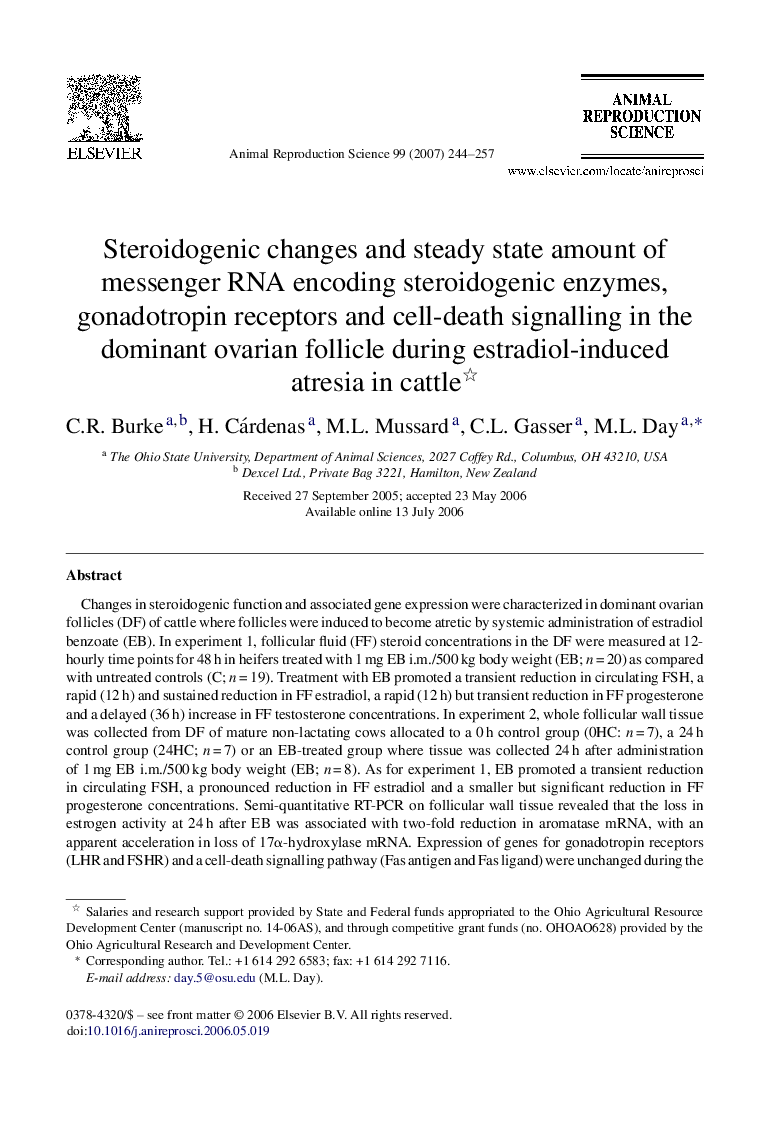| کد مقاله | کد نشریه | سال انتشار | مقاله انگلیسی | نسخه تمام متن |
|---|---|---|---|---|
| 2074819 | 1544817 | 2007 | 14 صفحه PDF | دانلود رایگان |
عنوان انگلیسی مقاله ISI
Steroidogenic changes and steady state amount of messenger RNA encoding steroidogenic enzymes, gonadotropin receptors and cell-death signalling in the dominant ovarian follicle during estradiol-induced atresia in cattle
دانلود مقاله + سفارش ترجمه
دانلود مقاله ISI انگلیسی
رایگان برای ایرانیان
موضوعات مرتبط
علوم زیستی و بیوفناوری
علوم کشاورزی و بیولوژیک
علوم دامی و جانورشناسی
پیش نمایش صفحه اول مقاله

چکیده انگلیسی
Changes in steroidogenic function and associated gene expression were characterized in dominant ovarian follicles (DF) of cattle where follicles were induced to become atretic by systemic administration of estradiol benzoate (EB). In experiment 1, follicular fluid (FF) steroid concentrations in the DF were measured at 12-hourly time points for 48 h in heifers treated with 1 mg EB i.m./500 kg body weight (EB; n = 20) as compared with untreated controls (C; n = 19). Treatment with EB promoted a transient reduction in circulating FSH, a rapid (12 h) and sustained reduction in FF estradiol, a rapid (12 h) but transient reduction in FF progesterone and a delayed (36 h) increase in FF testosterone concentrations. In experiment 2, whole follicular wall tissue was collected from DF of mature non-lactating cows allocated to a 0 h control group (0HC: n = 7), a 24 h control group (24HC; n = 7) or an EB-treated group where tissue was collected 24 h after administration of 1 mg EB i.m./500 kg body weight (EB; n = 8). As for experiment 1, EB promoted a transient reduction in circulating FSH, a pronounced reduction in FF estradiol and a smaller but significant reduction in FF progesterone concentrations. Semi-quantitative RT-PCR on follicular wall tissue revealed that the loss in estrogen activity at 24 h after EB was associated with two-fold reduction in aromatase mRNA, with an apparent acceleration in loss of 17α-hydroxylase mRNA. Expression of genes for gonadotropin receptors (LHR and FSHR) and a cell-death signalling pathway (Fas antigen and Fas ligand) were unchanged during the initial 24 h of EB-induced atresia. These results suggest that EB initiates atresia in dominant ovarian follicles through a rapid suppression of follicular estradiol synthesis, an effect associated with down-regulation of the aromatase gene. A transient suppression in circulating FSH following administration of EB appears to have initiated these events, and it is suggested that subsequent processes involved in atresia follow this loss in estrogenic function.
ناشر
Database: Elsevier - ScienceDirect (ساینس دایرکت)
Journal: Animal Reproduction Science - Volume 99, Issues 3â4, June 2007, Pages 244-257
Journal: Animal Reproduction Science - Volume 99, Issues 3â4, June 2007, Pages 244-257
نویسندگان
C.R. Burke, H. Cárdenas, M.L. Mussard, C.L. Gasser, M.L. Day,